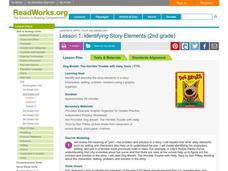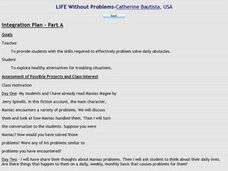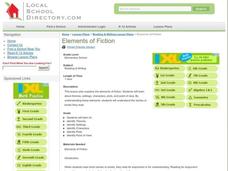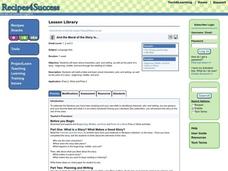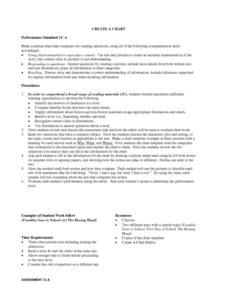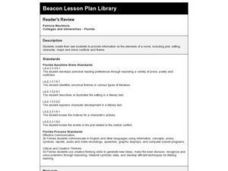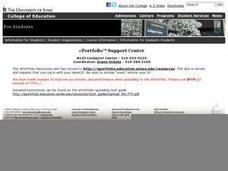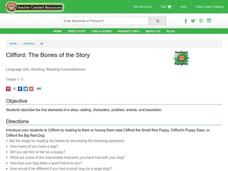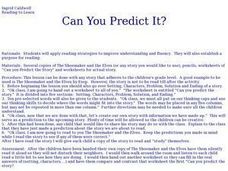Nazareth College
Creative Writing
Students discuss creative writing—what makes something creative writing? Each learner starts writing a story and after 15 minutes, they pass their story to another who adds to it. After another 15 minutes of writing, the story is passed...
Curated OER
Identifying Story Elements
Second graders explore story elements. In this language arts lesson plan, 2nd graders identifying characters, setting, and plot in familiar stories. Students listen to a story and complete a graphic organizer.
Curated OER
Elements of Fiction
Students investigate themes and settings in their favorite fiction stories. In this creative writing lesson, students discuss the reasons a fictional story works well and discuss ways to create their own. Students create...
Curated OER
Prince Ibrahima
Sixth graders read and utilize the facts from the story "Abd al-Rahmen Ibrahima" by Walter Dean Myers to analyze the main character's life which is ruined by conflict, jealousy, and greed. Journal entries are created in response to the...
Curated OER
When A Story Met A Sandwich
How is a story like a peanut butter and jelly sandwich? Use making a sandwich as a metaphor to remind your writers that a good, solid beginning, a rich and rewarding middle, and an ending that brings everything together spices up a...
Curated OER
Maniac Magee: Life Without Problems
Young readers discuss how they would deal with problems faced by the main character in Maniac Magee. They write down their own problems and exchange them with others to analyze and provide possible solutions. They establish a "Dear Abby"...
Curated OER
The "Write" Stuff: Strategies and Conventions for Imaginative Writing
Fifth graders develop and practice the steps involved in imaginative writing. They follow the steps/worksheets included and write imaginative stories of their own.
PBS
Figurative Language and Foreshadowing in The Outsiders
S.E. Hinton's The Outsiders is still relatable to teenagers today, even though it was written more than 50 years ago. Explore how the figurative language of the story works to establish characterization, and how foreshadowing lays...
Curated OER
Dragonwings: Explore Chapters 1-5
If you are beginning Laurence Yep's Dragonwings, this will provide activities for the first five chapters. The objectives include making connections to oneself and the world, organizing information and events, vocabulary acquisition,...
Curated OER
Sam and the Lucky Money
Third graders read the story "Sam and the Lucky Money". Individually, they identify new key terms from the story. In groups, they examine the setting and discuss how it relates to the plots and characters. To end the lesson, they read...
Curated OER
Elements of Fiction
Students identify key story elements in a fiction text. In this literacy lesson, students are introduced to the various elements of fiction such as the setting, plot, and theme. Students read a short story of their choice and identify...
Curated OER
And the Moral of the Story is...
Learners discover the parts of a story through the retelling of a fable as well as characters, plot, and setting. This activity is completed using the program Pixie to create an online storybook.
Curated OER
Create a Chart
Students create charts for story elements. They read two selections that share a common theme and discuss the story elements. They create a chart for the characters, plot, and setting and complete it while reading the selections.
Curated OER
Identifing Elements of Narrative Writing
Students explore the concepts of narrative writing. They identify the basic elements in narrative writing such as the setting description, characters, conflict, climax and resolution. Using five adjectives from a previous spelling unit,...
Curated OER
Text Under the Microscope
Students explore plot, setting, point of view, and theme. In this literary elements instructional activity, students read "The Cask of Amontillado," by Poe and the War of the World script by H.G. Wells. Students identify...
Curated OER
Reader's Review
Pupils create booklets to provide information on elements of a novel, including plot, setting, character, major and minor conflicts and theme.
Curated OER
Character Traits
First graders identify the story elements in stories. In this story element lesson, 1st graders read The Tale of Peter Rabbit by Beatrix Potter and they identify the characters, character traits, setting, problem, and solution. They...
Curated OER
Introduction to Little House Books
Third graders identify the main characters in the Ingalls family and describe the relationships between the characters. They locate the setting of the book on a map of the Upper Mid- West. Students understand that the books are set in...
Curated OER
Parts of a Story
Learners read a short fiction book and demostrate comprehension by identifying the main characters, setting, conflict, theme, and summarizing the main points. They organize the information in Inspiration and create a powerpoint to show...
Curated OER
The Bones of the Story
Students describe the five elements of a story--setting, characters, problem, events, and resolution. They use the Clifford series of books, and a worksheet imbedded in this lesson to help them explain the five elements of a story.
Curated OER
Design a Book Cover
Students use the programs Pics4Learning and ImageBlender 3 to apply their knowledge of characters, plot, setting, symbolism, and conflict to design and create a book cover. Designed as a culminating literature activity.
Curated OER
Chocolate Chaos
Second graders demonstrate the ability to examine the elements of a story (theme, plot, setting, mood) and characters, by discussing and writing about each. They have fun with chocolate related activities and enjoy reading about some...
Curated OER
Can You Predict It?
Students apply reading strategies to improve comprehension and fluency. They establish a purpose for reading. Students read the The Shoemaker and the Elves by Esop. They go over the setting, characters, problem, solution and ending of a...
Curated OER
Multimedia Book Reports
Students read a chapter book of 100-200 pages in length. They create a story map and multimedia book report. Pupils review the elements of a story map such as: characters, setting, problem, important events, solution, etc.) Students...

